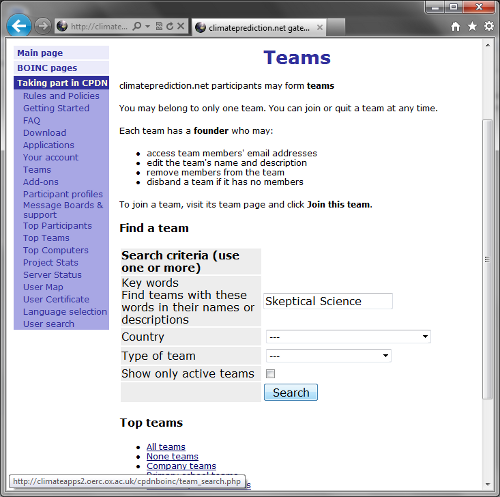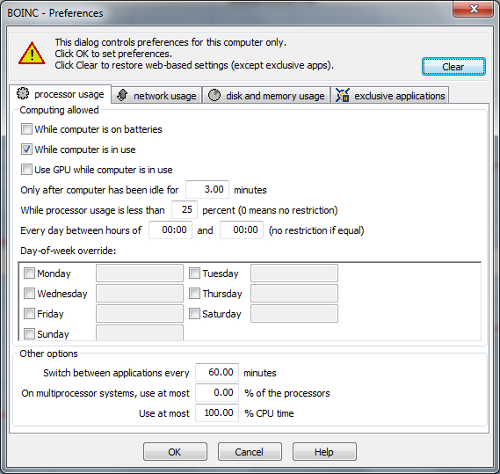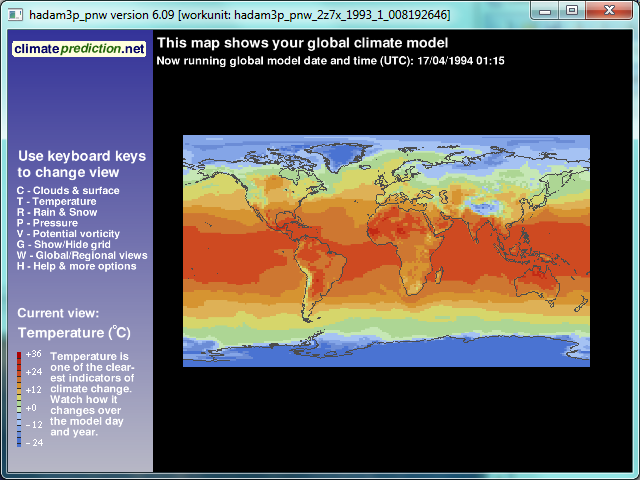Participate in Citizen Science with the new SkS BOINC team
Posted on 12 December 2012 by Steve Brown

We've discussed in the past how the general public can make a real contribution to scientific discovery by highlighting some of the citizen science projects that you can participate in. Now is your chance to join the Skeptical Science team in participating in the grand-daddy of Internet based citizen science: the Berkeley Open Infrastructure for Network Computing, otherwise known as BOINC.
Some of the most difficult problems in science require huge amounts of computing power, such as modelling the Earth's climate, predicting weather, searching for evidence of the Higgs particle, or understanding how proteins can fold at the molecular level to aid the development of vaccines. BOINC started life as an open source grid computing framework that was developed to manage the venerable SETI@Home project at the University of California, Berkeley, where members of the public could donate some of their PC's CPU time and literally create a planet-sized virtual super-computer to look for signs of intelligent life buried in radio astronomy data. BOINC now facilitates the computation of dozens more science and computing projects for people to take part in real research at home.
We've now created a Skeptical Science team across all of the BOINC enabled projects and it is open to any of you who want to join with us. In return, you will get a nice gooey feeling that you are making an active contribution to real scientific endeavours, as well as the excitement of following the team league statistics. We're already ranked 8,880 out of 97,111 teams in the BOINC worldwide league table! Detailed SkS team stats are available here.
Getting Started with BOINC
Follow these steps to get started. If you are already running BOINC, then proceed to STEP 2:
STEP 1: Choose a project and download the BOINC software here: http://boinc.berkeley.edu/. It works on Windows, Mac OS X, and Linux.
STEP 2: Once you've set up an account, you can join the SkS team from the "Join a Team" link on your project account page and search for "Skeptical Science". Please note that it may take up to 48 hours before your team membership is registered.

Figure 1: Example of a "Find a Team" page on the ClimatePrediction.net project site
STEP 3: Set your BOINC software preferences (Tools - Computing Preferences..) to instruct it how much CPU time to use, the time of day to run, and its priority over other applications you are running. By setting these preferences carefully, BOINC will run in the background unobtrusively and not result in too much additional power consumption.

Figure 2: BOINC Computing Preferences
Climate Prediction
The project that is most relevant to climate science is ClimatePrediction.net, which provides a global climate model to investigate a range of questions on how Earth's climate may change up to the year 2100. By serving up slightly different versions of the model parameters to participating PC's, experimenters are able to test the sensitivity and accuracy of the very large general circulation climate models running on multi-million dollar supercomputers at the leading research centres. There is a growing list of scientific publications that ClimatePrediction.net has generated, which you can access from here.

Figure 3: Visualisation of a ClimatePrediction.net project model running on my PC
From time to time there may be periods where the Climate Prediction project does not have any new work for you. This is usually due to the amount of effort it takes researchers to prepare new experiments. If this happens then be patient and BOINC will eventually download new work units as they appear. You can check the Climate Prediction Server status to see the availability of work units for your BOINC client: http://climateapps2.oerc.ox.ac.uk/cpdnboinc/server_status.html. There is also nothing to stop you from subscribing to multiple projects to ensure you keep your PC busy.

Figure 4: SkS BOINC team statistics. The team is currently running Climate Prediction (CPDN), Milky Way, and SETI@Home.































 Arguments
Arguments























 0
0  0
0






Comments